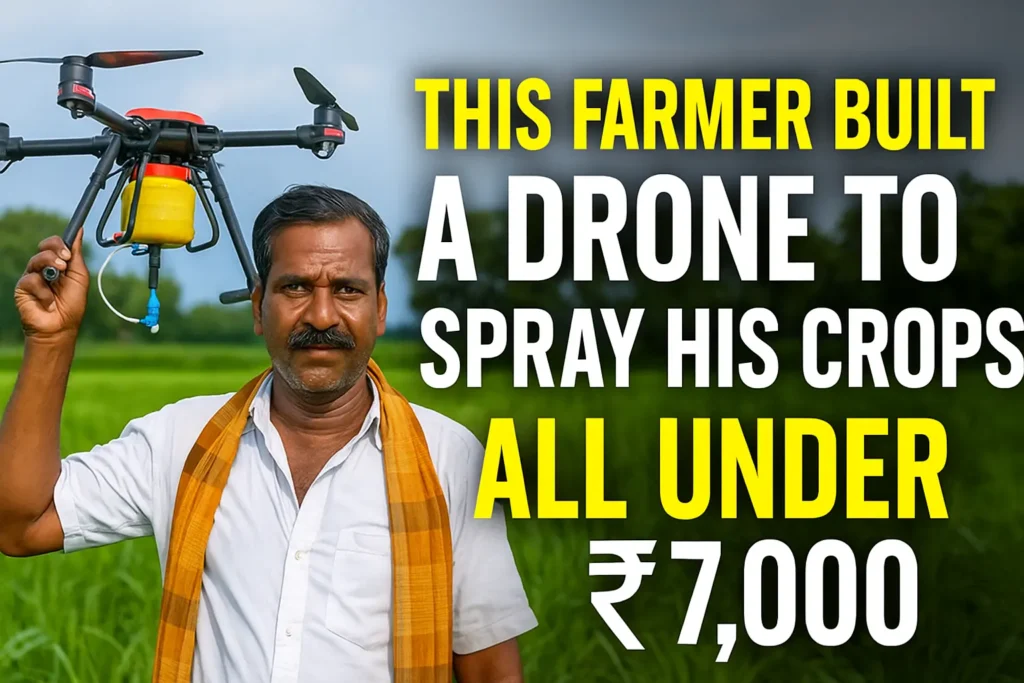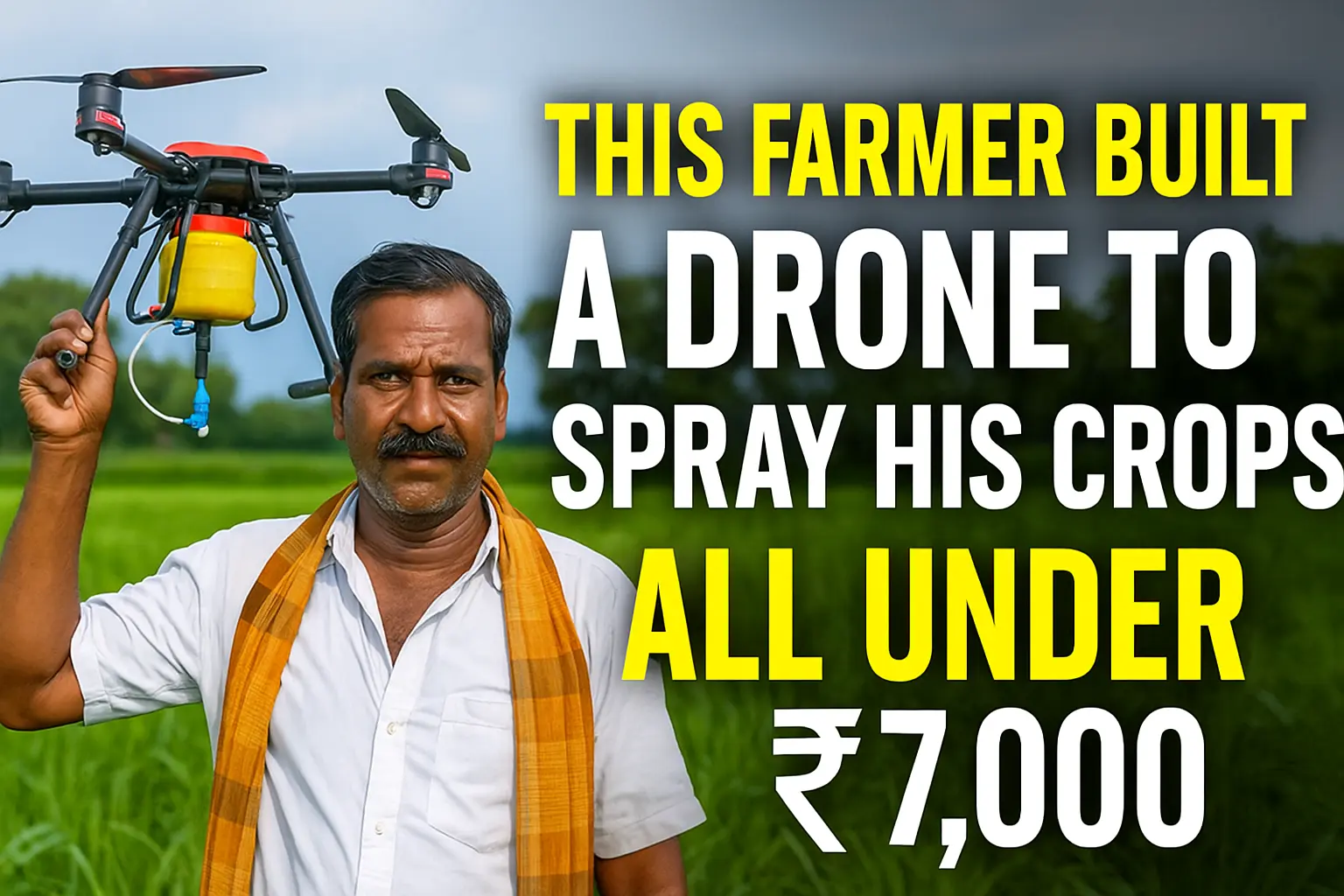In an age where agriculture is rapidly embracing new technologies, innovation isn’t always coming from expensive labs or multinational companies. Sometimes, it sprouts from the determination of everyday individuals working the soil. One such inspiring story comes from a small village in India, where a resourceful farmer built his own crop-spraying drone for less than ₹7,000. At a time when commercially available agricultural drones can cost anywhere between ₹1 lakh and ₹10 lakh, this accomplishment stands out as a beacon of frugality and innovation.
The farmer in question is not a tech graduate or an engineer by profession. He is a self-taught innovator, driven by necessity and an unwavering commitment to improving his farming methods. His story is as much about problem-solving as it is about resilience.
The Challenge: Expensive Spraying and Scarce Labor
In rural India, crop spraying is still largely done manually. This involves carrying a tank of pesticides or fertilizers on one’s back, walking through acres of fields under the scorching sun. For large farms, this process is not only exhausting but also time-consuming and often uneven in application. Labor shortages during peak agricultural seasons further aggravate the problem.
The farmer noticed these challenges firsthand. With limited resources and rising operational costs, hiring labor or buying commercial drones was simply out of the question. Yet, the need for a solution was urgent. Crop diseases were increasing, and uneven spraying was leading to yield losses. That’s when he decided to take matters into his own hands.
A DIY Drone Born from Scrap and Ingenuity
Using his savings and locally available materials, the farmer set out to build a drone from scratch. His goal was clear: create a low-cost drone capable of lifting and spraying liquid over small agricultural plots.
Here is how he approached the project:
- Drone Frame: He used lightweight metal rods and PVC pipes, sourcing parts from old bicycles and discarded machines.
- Motors and Propellers: Salvaged from broken ceiling fans and toy helicopters. These were carefully rewired to create thrust on a basic quadcopter model.
- Battery and Circuitry: Recycled lithium-ion batteries from old mobile phones and power banks were configured to provide adequate flight time.
- Remote Control Mechanism: Built using a modified TV remote circuit paired with basic Bluetooth modules. He used open-source Arduino code to control basic functions like lift, spray, and direction.
- Spraying Mechanism: A small pump motor, originally part of a discarded car wiper system, was used to spray pesticide. The spray nozzle was created from an old perfume bottle.
It wasn’t perfect on the first try. He faced crashes, battery issues, and wiring complications. But with persistence and hours of experimentation, the drone eventually became functional enough to cover small patches of his farm.
Performance and Practical Application
Once his drone was up and running, the farmer tested it over a small acre of standing crops. The results were not just satisfactory—they were revolutionary for his scale of operations. The drone could fly steadily for 10–12 minutes on a single charge and spray pesticides evenly across the crop canopy.
Although the capacity was limited to around 1 liter per flight, it was ideal for intercropping fields and localized disease control. Most importantly, it allowed the farmer to reduce human exposure to chemicals and save hours of manual labor.
Over the next few weeks, he began refining the drone. He installed a solar panel on his tool shed to recharge the drone’s batteries sustainably. He also added a manual override in case of Bluetooth failure and upgraded the spray nozzle for better coverage.

Community Impact and Wider Adoption
Word of this drone quickly spread through nearby villages. Curious neighbors and fellow farmers visited his field to watch the drone in action. Many were amazed to see a home-built machine that could perform a task usually reserved for expensive technology.
Local agricultural officers took note and even invited him to present the drone at a farmer-tech exhibition in the district. There, his model was applauded for its practicality and frugal engineering. A few NGOs working on rural technology offered to help him refine the prototype further and possibly train other farmers in building similar drones.
More importantly, the drone started a dialogue within the farming community about the value of low-cost innovation. It inspired discussions around how simple tools, when re-engineered creatively, can solve complex agricultural problems.
The Bigger Picture: Frugal Innovation in Indian Agriculture
This story reflects a broader trend in Indian agriculture—the rise of grassroots innovation. With limited access to advanced tools or formal education, many rural innovators are finding ways to repurpose scrap material, repurpose knowledge, and bridge the gap between need and affordability.
The Indian government has been pushing for digital and tech-enabled farming through policies like the Digital Agriculture Mission and subsidies on farm equipment. But for many small-scale farmers, access to these technologies remains limited. Stories like this one highlight why support for DIY technology, skill-building workshops, and open-source platforms can be far more impactful.
The ₹7,000 drone is not just a machine. It’s a symbol of empowerment. It demonstrates that the future of Indian agriculture doesn’t only depend on corporate innovations or high-end machinery, but also on empowering farmers to think, create, and solve problems with what they already have.
Potential for Scale and Future Improvements
While the current version of the drone is a prototype, it opens several possibilities. With some engineering support, this basic model can be improved to:
- Carry larger payloads
- Include GPS navigation
- Automate spraying paths with drone programming
- Integrate AI-based crop health analysis via camera sensors
Open-source platforms and rural innovation labs can help scale such solutions. If documented and replicated, such models can help thousands of small and marginal farmers improve efficiency without breaking the bank.
Local colleges and polytechnic institutes can also contribute by conducting rural hackathons, offering internships focused on agro-tech, and partnering with NGOs for field deployment of these grassroots solutions.
Final Thoughts
At a time when the cost of farming is rising and profit margins are shrinking, innovation from the ground up has never been more important. The story of this farmer and his self-built drone is more than just a case study. It is a testimony to what is possible when creativity meets necessity.
With the right support, training, and access to information, there could be hundreds of such innovations waiting to emerge from the heart of India’s villages. And perhaps, the next big agricultural revolution won’t start in a corporate boardroom—but in a humble tool shed behind a paddy field.
